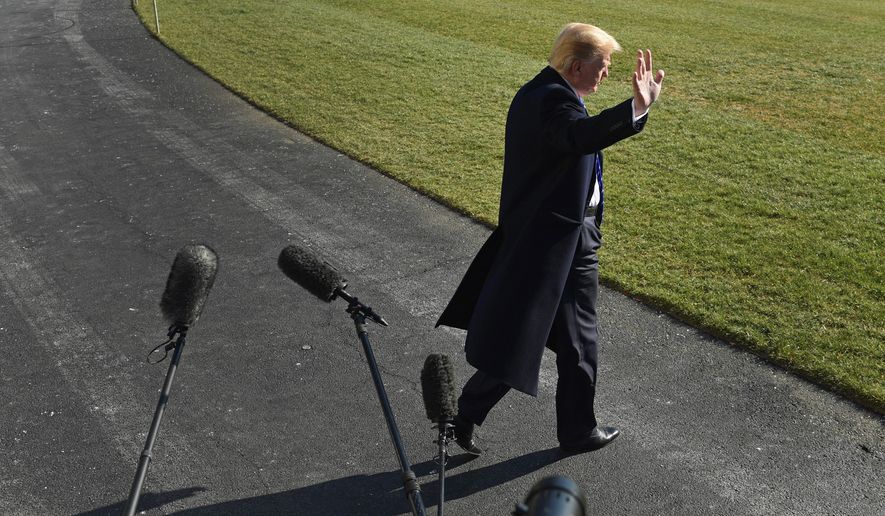The hostility with which President Trump and the news media regard each other has only intensified during his first year in the White House, even as the president engaged in an unprecedented level of interaction with reporters.
Mr. Trump allowed pool sprays and other events that usually would be relegated to photo ops to become impromptu press conferences. He responded to more than 500 questions from reporters during these encounters, according to a tally by The Washington Times.
His walks across the South Lawn to and from Marine One routinely become question-and-answer sessions with reporters along the rope line. He has taken questions there on 13 occasions, responding to 42 questions during a single session in October.
By comparison, President Obama took questions twice when leaving or arriving on the Marine helicopter, and both times there was a podium placed there for the event, according to meticulous lists kept by Mark Knoller, White House correspondent for CBS News.
During two days of golfing in August at his private golf club in Bedminster, New Jersey, Mr. Trump took at least 50 questions from reporters at various spots around the club.
However, all this access to the president has not made the interaction between the White House and the press corps less combative. To the contrary, the news media has become more aggressive and accusatory in its coverage, while the president and his staff regard reporters with open disdain.
American University professor Patricia Sykes, a scholar of the presidency and comparative executive leadership, said the frequent interaction with reporters constitutes more access to Mr. Trump personally but not greater access to the information that reporters want and need.
“Frequent press conferences can fuel the illusion that this president is open and accessible when, in fact, the Trump White House has been far less transparent and more secretive than most of his predecessors,” she said. “The president seems to enjoy the theatrical aspects of the interaction If reporters want useful information, perhaps they should engage in less direct interaction and more serious observation from a distance.”
Mr. Trump has avoided formal press conferences. He has held only one solo White House news conference.
That hastily arranged news conference in February was staged for Mr. Trump to blast the news media as “out of control” and to defend his young administration as running like a “fine-tuned machine.”
“The media’s trying to attack our administration because they know we are following through on pledges that we made, and they’re not happy about it,” he told reporters at the freewheeling exchange, where he took nearly 100 questions.
President Obama had five formal, solo White House news conference during his first year in office. President George W. Bush had four during his first year at the White House, according to Mr. Knoller’s lists.
The Trump White House kept reporters guessing about whether the president would hold a traditional end-of-year news conference until Mr. Trump departed for his Mar-a-Lago Club in Florida, where he spent Christmas and New Year’s.
The simmering animosity boiled over at a daily press briefing in December, when White House press secretary Sarah Huckabee Sanders spared with reporters over a rash of erroneous reports that news outlets were forced to either retract or correct.
“You cannot say it is an honest mistake when you are putting up information that is purposefully false,” said Mrs. Sanders, scolding CNN reporter Jim Acosta for claiming the false reports were “honest mistakes.”
However, the feeling was mutual. The daily briefings end as often as not with reporters shouting questions at Mrs. Sanders about whether Mr. Trump has lied to the American people.
It is also a contest in which both sides are losing.
Mr. Trump’s job-approval rating hovers around 39 percent, with 56 percent disapproving of his performance in the Oval Office, according to the Real Clear Politics average of recent surveys.
The president’s approval rating never cracked the 50 percent mark this year in the Gallup daily tracking poll.
Meanwhile, nearly half of voters — 44 percent — think the news media makes up stories about the president and his administration, according to the 2017 Poynter Media Trust Survey released last week.
A Reuters/Ipsos poll in October found that less than half of American adults trust either the news media or the president. For both, 48 percent of adults said they had a “great deal” or “some” confidence in them.
For the news media, that was an improvement from a previous survey in November 2016 that showed 45 percent trusted the news.
Mr. Trump’s trust rate had ticked down from 51 percent in the previous poll.
Despite his frequent tweets about “fake news,” the president recent showed a slight improvement in his view of reporters.
Since his days on the campaign trail, Mr. Trump frequently points out the news media at events and describes them as “the most dishonest people you’ll ever meet.”
It is always an applause line.
He often qualifies his judgment of reporters by allowing that 20 percent to 25 percent of them are “all right.”
In a speech last month to graduates at the FBI National Academy in Quantico, Virginia, the president upped it to 30 percent.
“There’s the fake news back there. Look, everybody,” Mr. Trump said to laughs from the crowd. “Fake news. No, actually, some of them are fine people. About — let’s see, who’s back there? Yeah, about 30 percent.”
• S.A. Miller can be reached at smiller@washingtontimes.com.




Please read our comment policy before commenting.